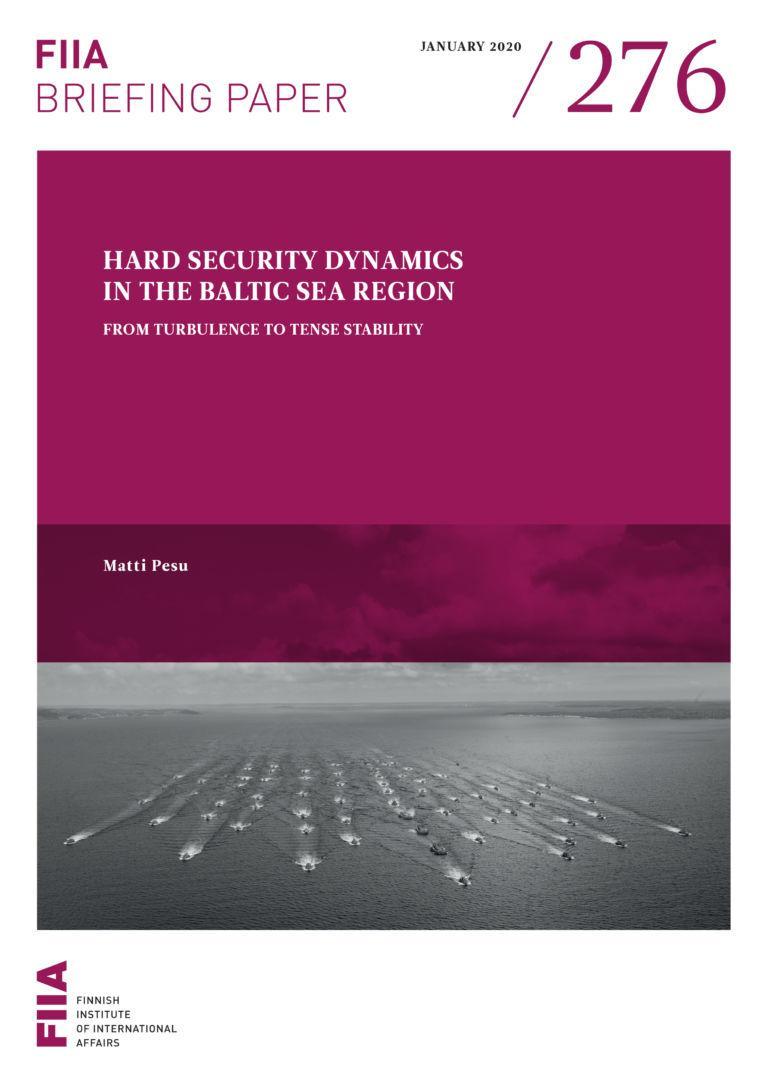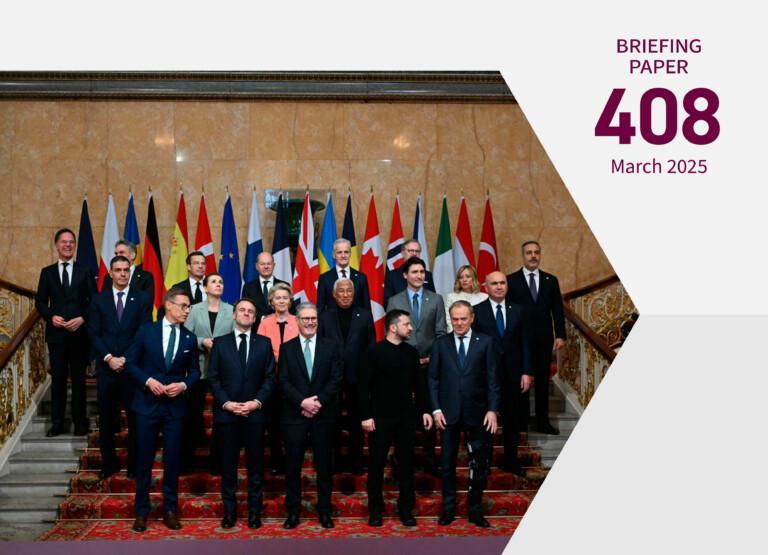
- After a period of turbulence in 2014–2015 followed by Russia’s actions in Ukraine, tense stability has emerged in the Baltic Sea area.
- The current regional security landscape is shaped by three interconnected security dynamics: Russian assertive behaviour, NATO’s reassurance and deterrence measures, and Finland’s and Sweden’s closer integration into the Western deterrence network.
- The interplay between the dynamics will determine the nature of the regional security environment in the 2020s. Russia’s provocative measures in the region or elsewhere will likely strengthen the foothold of Western security structures in the Baltic Sea area.
- Moreover, NATO, Finland, and Sweden should continue to find ways to enhance stability without unnecessarily feeding Russian provocativeness.
- The sources of regional tensions lie elsewhere, and the Baltic Sea region will remain a contested area as long as the West and Russia are at loggerheads.
Introduction
This Briefing Paper looks into the fundamentals of the Baltic Sea security landscape in the early 2020s. It argues that three interconnected security dynamics shape the present, ‘post-2014’ security environment in Northeastern Europe. That is to say, Russia’s assertive behaviour in the region and in Europe more broadly, NATO’s reassurance and deterrence measures in the area, and Finland’s and Sweden’s closer integration into the Western defence network all affect hard security dynamics in the Baltic Sea region.
These three dynamics underlie the tense regional stability that emerged after a period of alarmism and turbulence in the immediate aftermath of Russia’s actions in Ukraine. Fundamentally, the stability is the product of the interplay between the three dynamics. In other words, NATO’s reassurance and deterrence measures accompanied by Finland’s and Sweden’s integration into the Western security and defence system act as a counterweight to Russia’s actions in the region, creating a balance of power holding Russia’s ambitions in check.
Investigating the sources of regional balance is relevant for multiple reasons. The region remains a potential hotspot between Russia and the West and, thus, it merits close and continuous attention. Moreover, the word ‘stability’ frequently features in foreign policy parlance in Northern Europe, particularly in Finland and Sweden. Given this rhetorical proclivity, attention needs to be paid to the factors that actually constitute stability and the state of hard security in the Baltic Sea area.
The paper consists of three analytical parts. First, it provides a brief historical overview of the twists and turns in the regional security landscape from the early post-Cold War era to today. The second part introduces the three dynamics in detail, followed by an analysis of how they are interconnected. The paper concludes by contemplating how regional stability could best be preserved in the 2020s.
The post-Cold War Baltic Sea: from low tensions to turbulence
The end of the Cold War resulted in two notable changes in the security situation in the Baltic Sea area. Firstly, the Western politico-military order extended to the region in the form of the respective enlargements of the EU and NATO. Russia, bedevilled by major domestic challenges, remained outside the post-Cold War European security architecture. In the Baltic Sea region, this implied that Russia no longer enjoyed a predominant position. Rather, it retreated to the easternmost corner of the area, with the exception of the Kaliningrad Oblast, which remained as the sole Russian outpost along the Baltic coast.
The second notable development was the emergence of cooperative security arrangements among the regional countries, including Russia. The Council of the Baltic Sea States, the EU’s Northern Dimension, and the EU Baltic Sea strategy all exhibited an improved cooperative spirit between the West and Russia, facilitating concrete cooperation among regional states.[1]
The Baltic Sea region remained an area of low tensions until Russia’s foreign policy began to embrace assertive tones in the late 2000s. The increased Russian belligerence was exemplified in cyberattacks against Estonia, the war in Georgia, and large-scale military exercises such as Zapad-09.
The trend of mounting tensions continued in the early 2010s. Indeed, 2013 was a harbinger of the bleaker developments to come. The year witnessed the Zapad-13 exercise and the Russian simulated attacks against Sweden and Denmark. Moreover, in the Steadfast Jazz exercise, NATO finally tested its ability to defend the Baltic states and Poland, which signalled that collective defence was slowly returning to the heart of the Alliance’s agenda.[2]
Future history books will treat 2014 as a game changer. Russia’s violation of Ukraine’s territorial integrity was also a watershed for Baltic Sea security. Russia demonstrated its willingness to resort to military force against its neighbour. The Baltic states in particular felt ever more vulnerable to the looming Russian threat. Pundits across the Euro-Atlantic region speculated about Russia’s next potential victims, and the Baltic states frequently featured in these musings. As a result of the worsened security situation in Europe, turbulence and dangerous incidents increased in the Baltic sea region, especially in 2014–15. Storm clouds appeared to be gathering, and some commentators anticipated a ‘Narva scenario’, in which Russia would use hybrid tactics against Estonia’s eastern parts, populated by ethnic Russians. A period of turbulence and uncertainty shook the Baltic Sea region.
However, despite the numerous incidents in and around the Baltic Sea, and contrary to many bleak assessments made in the charged aftermath of the events in Ukraine, the Baltic Sea security situation has not overheated. Alarmist comments have also decreased. Narva remains intact and Russia has not tried to challenge the regional status quo by using military force. Rather, it seems that the frequency of risky incidents has decreased and a tense state of balance and stability has emerged in the Baltic Sea region. In fact, such stability is characterized by three different hard security dynamics that have matured during the more tense and contested era.
The three hard security dynamics of the post-2014 security environment
Russian assertive behaviour
The first dynamic relates to Russia’s behaviour in the region and elsewhere, particularly in Europe and its vicinity. Indeed, it is crucial to note that Russia’s behaviour outside the region may also affect the Baltic Sea security landscape. Ukraine stands as an extreme example, as pointed out.
In order to understand Russia’s policy vis-à-vis the Baltic Sea area, one must appreciate the key tenets of Moscow’s security policy. Experts on Russian strategy broadly agree that its strategic behaviour is driven by a rather coherent approach to international security. Moscow’s approach combines both offensive and defensive elements, and it uses various policy tools holistically to accomplish its objectives. Simultaneously, the line between peace and war has become blurred.[3]
The Russian holistic approach to promoting its interests has been developing during the post-Cold War era. However, it truly challenged the foundations of Baltic Sea security only after its illegal actions against Ukraine, which were also the decisive factor that changed the nature of the Baltic Sea area.
In terms of concrete measures in the region, Russia has exercised its integrated policy, which, as said, combines offensive and defensive actions. Its military measures have included simulated military attacks, nuclear threats, deployments of advanced dual-capable missile systems, air-space violations and other violations of territorial integrity, and large-scale military exercises such as Zapad-17. Other means targeted against the region’s countries have entailed the weaponisation of migrant flows, intelligence operations, and disinformation campaigns. The Baltic states in particular are vulnerable to this sort of hybrid influencing.[4] The bottom line is that Russian’s action clearly demonstrates its readiness to use audacious and offensive measures.
Russia has multiple objectives in the area. First, in its active behaviour it seeks to protect its Northwestern flank and, ultimately, to guarantee regime survival against perceived threats from the West. Furthermore, it seeks to prevent further NATO enlargement to Finland and Sweden, and to strive for maximising its political influence in the area close to its borders. Moreover, the Baltic Sea region is also an arena in which it can demonstrate its growing military prowess, which again highlights Russia’s great power status. Muscle-flexing and subversive political actions also signal its revisionist attitude towards the existing European security architecture.
It is vital to recognise that many of Russia’s goals in the region are second-order concerns, meaning that it uses the region to undermine broader European and transatlantic structures such as the EU and NATO.[5] However, importantly, Russia is unlikely to use military force against NATO members or Finland and Sweden. Yet this scenario cannot be ruled out altogether.
Western reassurance and deterrence measures
Disturbing Russian behaviour has led to Western reassurance and deterrence measures in the region, boosting the credibility of the Baltic states’ and Poland’s own deterrence efforts. In actual fact, due to a considerable imbalance in military power, the regional NATO members have to rely on extended deterrence.
In Wales in 2014, NATO launched the so-called Readiness Action Plan, which included adaptation and assurance measures, such as the decision to launch NATO’s Very High Readiness Joint Task Force (VJTF). At the 2016 Warsaw Summit, the Alliance decided to introduce Enhanced Forward Presence (EFP) – a rotational military presence in the three Baltic states and Poland with four multinational battalions. Each battle group has a lead nation – the United Kingdom in Estonia, Canada in Latvia, Germany in Lithuania, and the United States in Poland – and there are currently a little under 5,000 combat-ready NATO soldiers in the Baltic Sea region, in addition to the member states’ own troops.
The United States, in turn, launched its own Atlantic Resolve Operation in April 2014, which remains ongoing. EFP, which became operational in June 2017, replaced the US presence in the Baltic states. However, the US has 4,500 rotational troops in Poland, and it plans to reinforce the contingent by 1,000 soldiers in the near term.
Western deterrence measures in the Baltic Sea region are based on the idea of a ‘tripwire’. In other words, the relatively modest presence of multinational battle groups, which are clearly outnumbered by Russia’s military forces in its Western Military District, aim at convincing Russia that an attack against any of the regional NATO members will activate a reinforcement strategy against the aggression.[6] Hence, the policy is based on the ‘deterrence by punishment’ approach, rather than ‘deterrence by denial’, which would require stationing a military force able to deny any potential aggressor confidence in achieving their aims against a member state. Importantly, nuclear weapons remain the very foundation of NATO deterrence. [7]
NATO has made multiple decisions to flesh out a reinforcement strategy. The establishment of the VJTF provides thousands of soldiers ready to deploy within days. The Alliance has also agreed on a ‘30-30-30-30 plan’, which requires NATO to have 30 land battalions, 30 fighter squadrons and 30 vessels ready to deploy within 30 days of being put on alert. Furthermore, both NATO and the EU are investing in military mobility, which is an essential enabler of a credible reinforcement strategy. NATO has also enhanced its command structures, paying special attention to military mobility in Europe and to the protection of the sea lines of communication in the North Atlantic.
Rehearsing the implementation of the strategy is imperative for the allies. For example, the Defender 2020 exercise organized by the US Army will be a major effort that will put the Alliance to the test in terms of its capability to defend its European members. For the first time since the end of the Cold War, the US will exercise its ability to send a sizeable contingent – 20,000 soldiers – from the US mainland to Europe, including the Baltic states and Poland.
Finland’s and Sweden’s integration into the Western deterrence system
The final, often overlooked, security dynamic is Finland’s and Sweden’s respective integration into the Western deterrence system. The defence policies of the two states increasingly serve the goals of Western policy, namely deterring Russia in Northern Europe. Moreover, both states are stepping up their cooperation with NATO and its key members in order to generate interoperability in the context of territorial defence in the region.
Russia’s actions in Ukraine brought about increased incentives for Finland and Sweden to seek external support for their security. NATO, in turn, refocused its energy on territorial defence, the Baltic Sea region being a new priority. Although Finland and Sweden decided to remain nominally militarily non-aligned, they have made the most of the new opportunities created by the new security landscape.
Although Helsinki and Stockholm have made multiple national decisions to boost their defence capabilities, the most notable change in Finland’s and Sweden’s respective policies has been the emergence of robust defence cooperation. The states are NATO’s enhanced partners, and they have signed Host Nation Support Agreements with the Alliance. The Nordic duo take part in NATO exercises – such as Trident Juncture 18 – on a regular basis, and they maintain consistent dialogue with the Alliance on the security situation in the Baltic Sea. Furthermore, Helsinki and Stockholm have participated in NATO’s CMX tabletop exercises, which practise and test the Alliance’s internal and partner consultation and decision-making procedures.
In addition to intensified NATO cooperation, Finland and Sweden have deepened collaboration with the US and other key NATO states such as the UK, France and Germany. Moreover, importantly, Finnish-Swedish bilateral defence cooperation has taken major leaps in the last five years. Both countries signal that they seek partners to defend their territory also in wartime. Finland enacted new laws in June 2017, which enabled receiving and giving military assistance by combat forces. Finland and Sweden are also committed to the mutual assistance clause of the Lisbon Treaty. Furthermore, both states regularly host foreign military troops on their respective soils. They are also active partakers in regional military exercises, such as Estonia’s annual military training events, most recently Hedgehog 18 and Spring Storm 19.
Finland’s and Sweden’s role in the area boils down to geography. Neither country can be factored out in a potential collective defence scenario in the region. Southern Sweden and Gotland are imperative for any operation in the Baltic states. Finland again has strong defence capabilities that cannot be omitted. From NATO’s perspective, it is important that the territory remains in Finnish hands in every possible scenario.
Interplay between the dynamics
As implied, the regional security dynamics are interconnected. Russia’s illegal actions in Ukraine led to NATO’s increased presence in Northern Europe. Russia’s behaviour also resulted in Finland’s and Sweden’s increasing readiness to deepen collaboration with their Western partners, as they became ever more concerned about Russia’s behaviour. Conveniently, increased US and NATO interests in the region generated ample opportunities for Helsinki and Stockholm to strengthen their ties with the Western alliance.
One can therefore claim that in terms of the Russian objective of undermining the European security order, its actions have been strikingly counterproductive. Owing to Moscow’s actions in Ukraine and elsewhere, NATO’s foothold has deepened in Russia’s immediate neighbourhood. Perhaps more importantly, Russia’s assertive actions pushed NATO to renew its old purpose of collective defence.
The connection between Russian audacity and a bolstered Western deterrence posture in Northern Europe is therefore evident. However, there is also a possibility that Western actions can feed Russian provocativeness. Finland’s and Sweden’s NATO membership would certainly spark a reaction from Moscow, inaugurating a new era of turbulence in the region. A key question is whether the turbulent period would be followed by increased stability, as Finland’s and Sweden’s NATO membership could potentially decrease ambiguity and thus enhance the effect of Western deterrence in the region. A significant challenge for decision-makers in Helsinki and Stockholm in the 2020s is to assess whether the possible benefits of NATO membership are outweighed by the short-term implications stemming from Russian counter-measures.
Policymakers in Brussels and Washington must again evaluate the risk of a regional security dilemma. In other words, NATO and its leading powers have to carefully consider whether their policies could push Russia – out of genuine concern or domestic political pressure – to increase belligerence in the region. This line of thinking is somewhat unpopular in the West but is observable in contemporary NATO policy. More specifically, the 1997 NATO-Russia Founding Act states that NATO carries out collective defence without substantial permanent stationing of combat forces in the new member states, including the Baltic states and Poland. This principle was reflected in the Alliance’s decision to establish a rotational rather than a permanent presence in the region.
However, as long as NATO and its member states do not plan to establish a sizeable and permanent military presence in the region, security dilemma concerns are almost entirely theoretical. There seems to be little appetite for such a move, as demonstrated by the US decision not to station troops in Poland on a permanent basis despite the tempting offer from Warsaw. Moreover, Russia will continue to enjoy military superiority in the region, and redressing the balance is not a realistic option for NATO. Consequently, Russia’s continuous allegations of NATO encirclement are political in nature, and do not likely reflect genuine threat perceptions.
Thus, the desirable course for the Alliance’s future policies is to enhance the credibility of the tripwire, and to strengthen the existing reinforcement strategy, by re-establishing a rotational US presence in the Baltic states as well, or by deploying air defence assets to the region, for example.
Baltic Sea security in the 2020s
The Briefing Paper has argued that Russia’s illegal actions in Ukraine in 2014 changed the hard security environment in the Baltic Sea region. The interplay between Russia’s assertive behaviour, NATO’s deterrence and reassurance measures, and Finland’s and Sweden’s integration into the Western deterrence network will determine the state of hard security in the region in the 2020s.
The current hard security dynamics will prevail as long as the confrontation between the West and Russia lasts. This fact is in line with the recent history of the Baltic Sea region. In other words, broader tensions outside the area have spilled over to Northeast Europe, defining the nature of regional security. No regional solution can remedy the sources of tension in West-Russia relations.
Obviously, dramatic changes in Euro-Atlantic security, such as the paralysation of NATO or US withdrawal from European security, would deeply affect the Baltic Sea security and change the fundamentals completely. The vitality of Euro-Atlantic defence cooperation is of utmost importance for the Western countries in the Baltic Sea area.
Although the interplay between the three dynamics has resulted in relative regional stability, there remains a risk potential in the region.[8] Russia’s assertive policy, which is mixing offensive and defensive measures, creates uncertainty and entails considerable risks. Incidents and accidents between Western and Russian military forces are possible. Therefore, the current era of tense stability should not be taken for granted. Small risk reduction measures could strengthen regional stability. Additional transparency and intensified communication between the Western regional actors and Russia could reduce risks of misunderstanding, for example.[9] Finland’s activity in improving air safety in the region is a good example of a helpful initiative, alleviating risks in the area.
Fortunately, there are signals that Western powers and Russia are willing to de-escalate tensions in the event that the security situation in the region deteriorates. For example, in Syria, where risks have run high for years, the US and Russia have managed to prevent escalation between their troops, in spite of very serious incidents that have taken place between US and Russian forces in the country.[10]
To conclude, it is essential that policymakers in and outside the Baltic Sea region understand the fundamentals of the regional hard security environment. A frank analysis of the security situation in the area should guide future decisions. Maintaining the regional balance requires cool-headed deterrence but also the willingness to establish dialogue to mitigate risks. Finland – and other Western actors in the region – should continue using both foreign and defence policy means to tackle regional challenges.
Endnotes
[1] See e.g. Magnus Ekengren, “A return to geopolitics? The future of the security community in the Baltic Sea Region,” Global Affairs 4, no. 4–5 (2018): 503–519.
[2] See e.g. Edward Lucas, The Coming Storm. Baltic Sea Security Report, (Washington D.C.: Center for European Policy Analysis, 2015), https://1f3d3593-8810-425c-bc7f-8988c808b72b.filesusr.com/ugd/644196_302ae06eff3a4f20ab59888b0ed73a0f.pdf.
[3] Kristin Ven Bruusgaard, “Russian Strategic Deterrence,” Survival 58, no. 4 (2016), 7–26; Dmitry Adamsky, “From Moscow with coercion: Russian deterrence theory and strategic culture,” Journal of Strategic Studies 41, no. 1–2 (2018), 33–60; Oscar Jonsson & Robert Seely, “Russian Full-Spectrum Conflict: An Appraisal After Ukraine,” The Journal of Slavic Military Studies 28, no. 1 (2015), 1–22; Harri Mikkola et al., “Hybridivaikuttaminen ja demokratian resilienssi: Ulkoisen häirinnän mahdollisuudet ja torjuntakyky liberaaleissa demokratioissa [Hybrid influence and democratic resilience: Opportunities for external harassment and the ability to resist in liberal democracies],” FIIA Report 55 (2018), https://fiia.fi/en/publication/hybridivaikuttaminen-ja-demokratian-resilienssi; Pentti Forsström, “Venäjän sotilasstrategia muutoksessa. Tulkintoja Venäjän sotilasstrategian perusteiden kehityksestä Neuvostoliiton hajoamisen jälkeen [Russian military strategy in change. Interpretations of the development of the foundations of Russia’s military strategy after the collapse of the Soviet Union],” (Helsinki: Finnish National Defence University, 2019).
[4] See e.g. Alexander Lanoszka, “Russian hybrid warfare and extended deterrence in eastern Europe,” International Affairs 91, no. 1 (2016), 175–195.
[5] Mark Galeotti, “The Baltic States as Targets and Levers: The Role of the Region in Russian Strategy,” Security Insights 28, April 2019, https://www.marshallcenter.org/mcpublicweb/mcdocs/security_insights_28_-_galeotti_-_rsi_-_march_2019_-_letter_size_-_ecp.pdf.
[6] Eva Hagström Frisell et al., “Deterrence by reinforcement – The strengths and weaknesses of NATO’s evolving defence strategy”, FOI-R--4843--SE, November 2019, https://www.foi.se/rapportsammanfattning?reportNo=FOI-R--4843--SE.
[7] Leo Michel & Matti Pesu, “Strategic Deterrence Redux: Nuclear Weapons and European Security,” FIIA Report 60 (2019), https://fiia.fi/wp-content/uploads/2019/09/fiia_report60_strategic-deterrence-redux.pdf.
[8] Katri Pynnöniemi & Charly Salonius-Pasternak, “Security in the Baltic Sea Region: activation of risk potential,” FIIA Briefing Paper 196 (June 2016), https://fiia.fi/en/publication/security-in-the-baltic-sea-region-2.
[9] Ulrich Kühn, Preventing Escalation in the Baltics: A NATO Playbook (Carnegie Endowment for International Peace: Washington D.C., 2018), https://carnegieendowment.org/files/Kuhn_Baltics_INT_final_WEB.pdf.
[10] See e.g. Thomas Gibbons-Neff, “How a 4-Hour Battle Between Russian Mercenaries and U.S. Commandos Unfolded in Syria,” The New York Times, May 24, 2018, https://www.nytimes.com/2018/05/24/world/middleeast/american-commandos-russian-mercenaries-syria.html.










